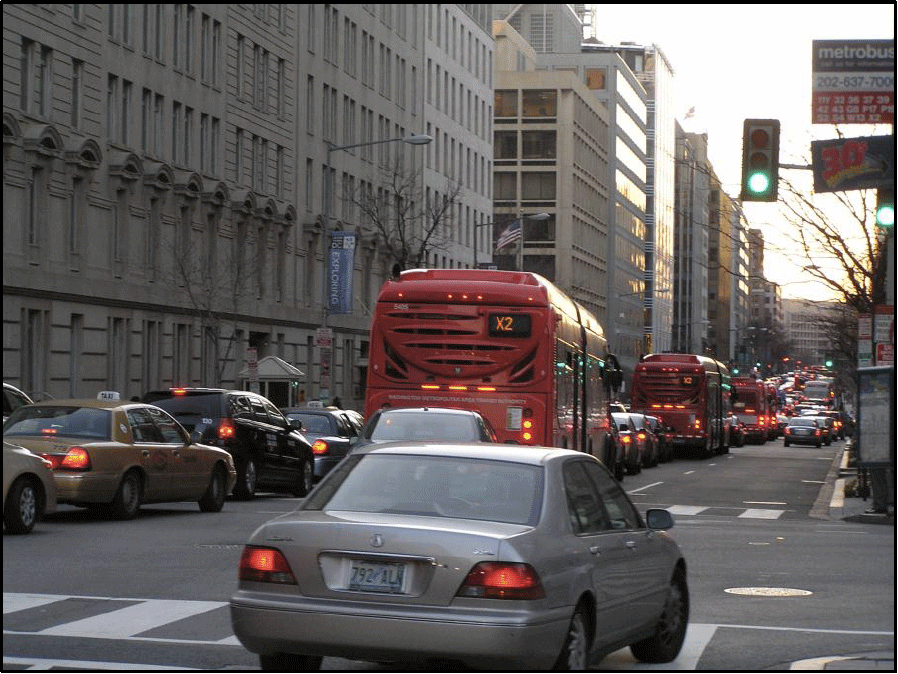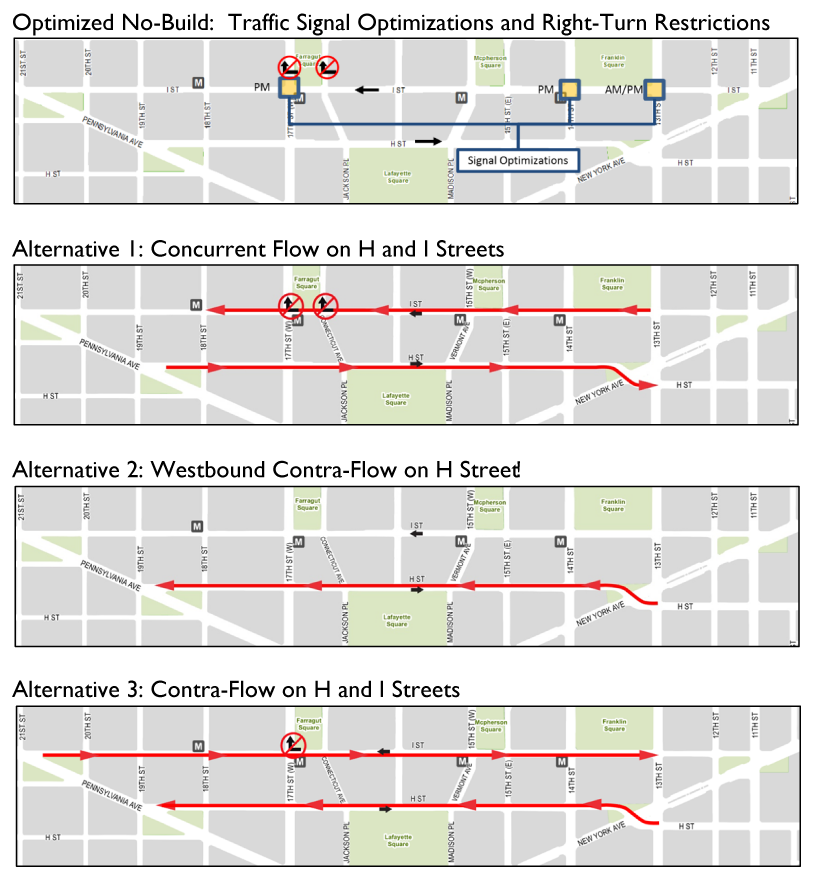H and I Streets Bus Improvements Study — Final Technical Report Released
Metro has released the final technical report of the H and I Streets Bus Improvements Study, making a compelling case for traffic management improvements and bus lane alternatives in the region’s most heavily traveled bus corridor.

Congestion on I Street caused by bottleneck at 17th Street, creating long queues backing up to 15th Street.
DC’s downtown core is a vibrant community, with 380,000 jobs today and significant residential and retail development in the coming decade. While growth will transform the core and create opportunities, it is likely to increase the burden on the transportation network that is already strained by the closure of Pennsylvania Ave.
Today, all users—drivers, bus passengers, pedestrians and bicyclists—experience congestion during peak periods. Besides high-volume traffic in the corridor, the constant friction among buses, vehicles and delivery trucks further aggravates travel experience. For bus passengers, the current corridor congestion severely affects travel time and service reliability—a short bus ride on I Street from 13th St to 19th St could take more than 10-15 minutes during rush hours.
Metro and DDOT collectively launched the H and I Streets Bus Improvements Study last year to explore bus improvements on H and I Streets NW in the downtown core, the region’s most heavily traveled and most productive bus corridor. The study investigated traffic management improvements and bus-only lane options with the objective of providing reliable and efficient bus service and alleviating Metrorail core congestion through innovative surface transit improvements.
The technical report is available for download (PDF) and posted on Metro’s Planning and Development webpage.
Four bus improvement options developed for analysis, as described and illustrated below:
- Optimized No-Build: traffic management improvements through traffic signal optimizations and right-turn restrictions;
- Alternative 1: weekday, peak-period, concurrent flow bus-only lanes on H and I Streets NW paired with right-turn restrictions at select intersections;
- Alternative 2: westbound-only contra-flow bus-only lane on H Street NW; and
- Alternative 3: contra-flow bus-only lanes on H and I Streets NW.

Illustrations of the alternatives evaluated under the H & I Streets analysis. Click image for larger version.
A comprehensive operations analysis found that all alternatives perform well.
- In the short-term, the Optimized No-Build improves traffic and transit travel times, provides immediate benefits to corridor users and allows flexibility for a later determination of transit investment.
- Among the bus lane alternatives, Alternatives 1 and 2 provide excellent returns on investment based on traffic simulation, operational assessment and benefit-cost analysis, including:
- Transit travel time savings up to 5 minutes (Alt 1) and 7 minutes (Alt 2) in the AM and PM rush-hour westbound direction, about half of today’s travel time. More travel time savings are expected in the future as traffic grows;
- 2.5 minutes in travel time savings for today’s vehicular traffic in the PM rush-hour westbound direction;
- High benefit-cost ratios, with Alternative 1 varying between 23 and 33 and Alternative 2 at 29.
The study also identified operational changes for implementing traffic management improvements and bus lane alternatives, such as restricting right-turns at the intersection of I St and 17th, removing on-street parking and loading areas for bus lanes, designating enforcement officers for the concurrent flow bus lane (Alternative 1) and changing H Street to two-way operations for the contra-flow bus lane (Alternative 2).
The findings of this study will support WMATA, DDOT and other stakeholders in determining the next steps of implementing bus improvements and evaluating the collective benefits and effects of the H and I Streets bus improvements and other planned transportation improvements on the downtown transportation network.
The videos below illustrate simulations of bus lane operations for Alternatives 1 and 2 in the PM peak hour.
Alternative 1: Concurrent-Flow Bus Lanes on H and I Streets, Aerial View
Alternative 2: Contraflow Lane on H Street, Aerial View
Alternative 2: Contraflow Lane on H Street, Dashboard View


It’s great that WMATA is considering these improvements, but if you have too many buses using a single lane, they start to get in each other’s way. You need passing lanes and intelligent stop spacing so that buses can actually move quickly along the route and unload at the same times. LA tried contraflow on Spring St in downtown and then removed it as many buses were getting stuck behind each other, with no space to pass.
http://www.humantransit.org/2010/05/ottawa-moving-on-from-the-busway.html
http://clkrep.lacity.org/onlinedocs/2005/05-1303_rpt_ladot_5-31-05.pdf
Also curbside contraflow can be dangerous, as people can accidentally step in front of a bus travelling the opposite direction from all other traffic and be killed. Design is critical and doesn’t show up on a computer simulation.
@Jacob I suspect that the buses won’t be going all that fast (doubtfully exceeding 25 MPH) and it’s difficult not to hear the sound of an approaching bus, so I doubt the contraflow lanes proposed here are all that dangerous. Definitely no more dangerous than the current setup where parking is removed during rush hour and used as an all purpose travel lane. I haven’t heard of anyone accidentally stepping in front of traffic and getting injured, much less killed, so I don’t see how the contraflow lane would be any different.
Wendy, or someone else at WMATA, it would be great if you could explain what the advantages of the contraflow lanes are, as opposed to the concurrent flow lanes.
Two advantages for the contra-flow bus lane: self-enforcement and traffic relief for I Street.
The contra-flow bus lane is self-enforcing. Compared to the concurrent flow bus lane, the contra-flow bus lane would eliminate the chance for other vehicles to access the bus lane, prevent buses from being blocked by right-turn vehicles, and require little enforcement effort.
The contra-flow bus lane on H Street would remove buses from I Street. Currently the curb lane on I Street is literally taken as a bus lane in the peak hour. Removing buses would effectively open up capacity for the westbound traffic on I Street.
@Wendy
In that case, why should the contraflow lane be on H Street, rather than I Street? It seems that an I Street bus lane would provide better connections to Metro and K Street buses.
Alternative 3 looked at a contra-flow bus lane on I Street. While the I Street contra-flow lane would benefit bus operations in the eastbound direction, it would have greater impacts on vehicular traffic. It would cause more delay in auto travel time in both AM and PM peak periods due to higher traffic volume on I Street. Additionally, it would still require right-turn restrictions at 17th Street, a difficult location for enforcements. The study report provides further details on the I Street contra-flow lane evaluation.